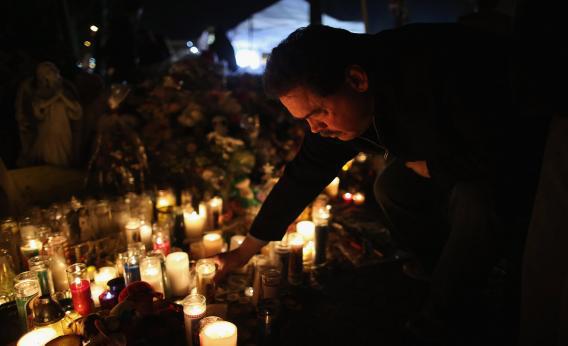Crime is Slate’s new crime blog. Like us on Facebook, and follow us on Twitter @slatecrime.
NEWTOWN, CONN.—At 6:30 p.m. on a rainy Tuesday night in Newtown, one week before Christmas, hundreds of people stand in the St. Rose of Lima parking lot, lined up to attend a wake for one of the 20 children killed last week in the shooting at Sandy Hook School. The line stretches out from the front door of the church, past an illuminated manger scene, past the two officers monitoring the entrance that has been cordoned off with police tape, winding through rows of cars all the way to the parish school, almost 100 yards away.
The church bell rings at 10-second intervals. A woman exiting the church touches the arm of one of the mourners. “They’re trying to get you in there, into the pews, so that you can be out of the cold,” she says, before giving her umbrella to someone else in the line. “God bless you,” she says.
It is funeral week in Newtown and Sandy Hook, and even though only a small number of families were directly victimized by the shootings, the entire region has resolved to share their pain. If there was ever a question of how Newtown would manifest its grief—if its sorrow would mutate into rage, fear, or withdrawal—it has been answered, as if the only proper response to a sudden subtraction is an influx of new numbers. The people of Newtown are present, and their empathy is palpable.
Outside the church, several hours after the service has officially begun, the line continues to grow despite the lateness and the rain. “It’s hard to believe that one person caused all this,” one man muses, looking behind him at the wet and patient crowd. “To think: this is just one-twenty-seventh of what’s going on.” Inside, hundreds more crowd the pews, aisles, and vestibule: praying, consoling, crying, remembering. The receiving line winds down the center aisle to the altar, where the victim’s family stands next to green and white wreaths, a floral heart that resembles an American flag, a candid photograph of three children on a beach, and a small white coffin.
Elsewhere, the streets are overrun by satellite trucks and stuffed animals. Impromptu memorials abound, in places where you’d expect them and in places where you wouldn’t: on the corner next to the Newtown police station, in a vacant lot across from the Mobil near the highway on-ramp. The line between private and public grief has eroded almost completely, and it disorients and overwhelms.
Downtown Sandy Hook smells like a Yankee Candle outlet. On the corner of Washington Avenue and Church Hill Road, there is a vast and growing shrine containing hundreds and hundreds of lit and extinguished candles, a zoo’s worth of stuffed animals, cards and photographs, the book Great Philosophers Who Failed at Love, and a whole lot more items. The memorial is dotted with signs left by out-of-town visitors: “Trumbull Is With You Heart and Soul,” “The Bronx is here with love.”
Up the road, at the turnoff to Sandy Hook School, the makeshift memorial I first saw on Saturday has sprouted into a grief garden. Twenty-three Christmas trees, each one topped with a decorative angel, line the side of the road, adorned with ornaments and stockings inscribed with the names of the dead. Even at night, people keep coming, climbing the small hill to pay their respects. A middle-aged woman loses her composure and is consoled by a stranger whose cap identifies him as a member of the Billy Graham Prayer Team. “You’re allowed to cry,” he says, pulling her close. “You’re allowed to cry.”
On Saturday, I speculated that the Newtown memorialists are driven by a need to commemorate an event that seemed to come from an entirely different world—that they were reaching out to touch an incomprehensible void. Now, all the candles and tributes seem more like an effort to refute that void, as if solidarity is the only weapon we have against senseless violence like this.
Elsewhere in America, in private and public conversations, the Sandy Hook shooting has become the catalyst for a wider discussion about policy and our national character. Which is fine. It’s natural and healthy that events like this prompt self-examination. The Sandy Hook shooting is the sort of inflection point that, throughout our history, has led us to choose what sort of country we are, want to be, and will become.
The people of Newtown have made their choice. Here, at least, people are still caught in the initial shock wave, a place where emotions are still raw and the solutions being discussed aren’t political ones. All over the city, windows bear a simple sign. “We are Sandy Hook,” it proclaims. “We choose love.”
